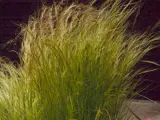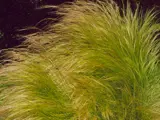(Mexican) Feather grass
Common name: Mexican feather grass, Finestemmed needle grass
Botanical name: Nassella tenuissima
Management category: Advisory
Originally from northern Mexico and south-western United States and brought to here as an ornamental plant.
Why is it a pest?
- It spreads incredibly quickly through prolific seed production with seeds remaining viable for up to four years.
- It will out-compete pasture and native species in open, coastal areas.
- It is a low protein, high fibre grass so has no grazing value for livestock and causes production loses for farmers.
- Stock forced to eat it get indigestible balls in their stomachs, leading to weight loss and starvation.
Where is it found?
- Sparsely scattered throughout Bay of Plenty.
- Large quantities of rough-coated seeds are spread by the wind.
- Particular risk areas include poor or dry pasture, open areas and coastal areas.
What does it look like?
- A densely tufted, perennial tussock grass that grows up to 70cm tall.
- Extremely tough, thin. Long leaves which do not break when pulled.
- Flowers between October and December with erect feathery flower heads that weep as they mature.
What are the rules?
Advisory
The Bay of Plenty Regional Council does not enforce the control of advisory species. It is landowner/occupier responsibility to manage these pests. Council may provide advice on how to manage or control these species if required.
How do you get rid of it?
Do not burn or graze, exclude all livestock.
- Dig out
- Spray (spring-summer)
CAUTION: When using any herbicide or pesticide, PLEASE READ THE LABEL THOROUGHLY to ensure that all instructions and directions for the purchase, use and storage of the product, are followed and adhered to.
Read more on pest control advice, information and regulations.
Images


